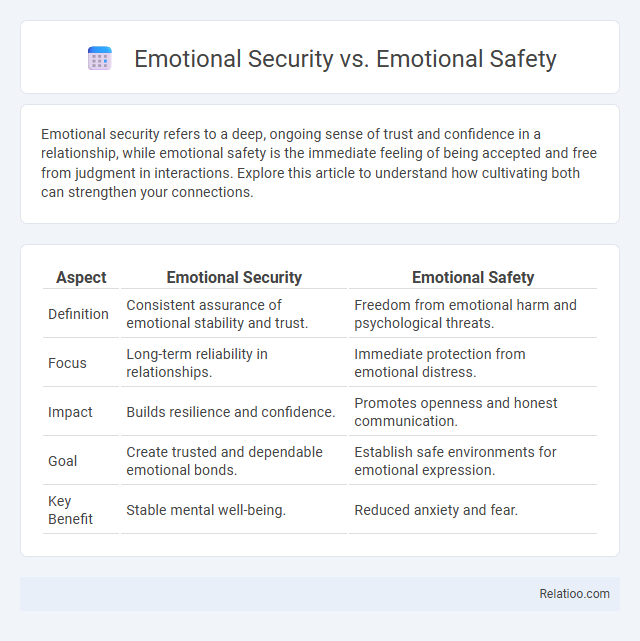Emotional security refers to a deep, ongoing sense of trust and confidence in a relationship, while emotional safety is the immediate feeling of being accepted and free from judgment in interactions. Explore this article to understand how cultivating both can strengthen your connections.
Table of Comparison
| Aspect | Emotional Security | Emotional Safety |
|---|---|---|
| Definition | Consistent assurance of emotional stability and trust. | Freedom from emotional harm and psychological threats. |
| Focus | Long-term reliability in relationships. | Immediate protection from emotional distress. |
| Impact | Builds resilience and confidence. | Promotes openness and honest communication. |
| Goal | Create trusted and dependable emotional bonds. | Establish safe environments for emotional expression. |
| Key Benefit | Stable mental well-being. | Reduced anxiety and fear. |
Understanding Emotional Security and Emotional Safety
Emotional security refers to a consistent sense of trust and stability in relationships, where individuals feel valued and accepted without fear of rejection or abandonment. Emotional safety involves creating an environment where people can express their true feelings openly, free from judgment or emotional harm. Understanding the distinction helps foster deeper connections by ensuring both reliability and openness in emotional interactions.
Key Differences Between Emotional Security and Emotional Safety
Emotional security refers to a deep, ongoing sense of confidence and trust in your emotional environment, while emotional safety focuses on the immediate feeling of being free from emotional harm or threat. Emotional security involves long-term stability and resilience in relationships, whereas emotional safety addresses short-term protection and comfort during interactions. Understanding these distinctions helps you build stronger, more supportive connections by recognizing when you need reassurance versus a safe space to express emotions.
The Role of Emotional Security in Healthy Relationships
Emotional security in healthy relationships fosters trust, stability, and open communication, allowing partners to express feelings without fear of judgment or abandonment. Unlike emotional safety, which emphasizes the absence of immediate threats, emotional security involves consistent reassurance and mutual support that strengthen relational bonds over time. Prioritizing emotional security promotes resilience and deeper intimacy, essential components for enduring and fulfilling partnerships.
Why Emotional Safety Matters for Personal Growth
Emotional safety creates a foundation where your feelings are validated, allowing vulnerability without fear of judgment or harm. This secure environment fosters personal growth by encouraging authentic expressions and resilience in facing challenges. Prioritizing emotional safety enhances self-awareness and deepens connections, essential for evolving emotionally and mentally.
Signs You Lack Emotional Security
Lacking emotional security often manifests in persistent feelings of anxiety, fear of rejection, and difficulty trusting others, which can undermine your well-being and relationships. Signs include constant seeking of validation, hypersensitivity to criticism, and avoidance of vulnerability due to fear of emotional harm. Understanding these indicators is crucial for developing healthier emotional safety and fostering genuine emotional security.
Identifying Emotional Safety in Your Interactions
Identifying emotional safety in your interactions involves recognizing environments where you feel accepted, respected, and free to express your feelings without fear of judgment or rejection. Emotional safety is marked by open communication, consistent support, and mutual trust that foster vulnerability and genuine connection. Distinguishing it from emotional security, which focuses more on long-term stability and reassurance, emotional safety is the immediate atmosphere that allows authentic emotional exchanges to occur.
Building Emotional Security: Practical Strategies
Building emotional security involves developing trust, self-awareness, and resilience to navigate relationships confidently. Your ability to establish clear boundaries and practice consistent communication fosters emotional safety, creating a protective environment for vulnerability. Practical strategies include mindfulness exercises, seeking supportive connections, and engaging in therapeutic techniques to enhance emotional regulation and deepen personal security.
Creating Environments of Emotional Safety
Creating environments of emotional safety involves fostering spaces where individuals feel accepted, understood, and free from judgment or harm. Emotional safety serves as the foundation for emotional security, which is the stable sense of trust and confidence in relationships that allows you to express feelings openly. Prioritizing emotional safety in personal and professional settings enhances psychological well-being and strengthens interpersonal connections.
Emotional Security vs Emotional Safety: Common Misconceptions
Emotional security refers to a stable sense of self-worth and confidence in one's relationships, while emotional safety involves feeling protected from emotional harm or judgment. Many people conflate emotional security with emotional safety, but your emotional security is about internal assurance, whereas emotional safety depends on external conditions created by others. Misunderstanding this distinction can hinder personal growth and the development of healthy, trusting relationships.
Integrating Both for Lasting Emotional Well-Being
Emotional security and emotional safety, while often used interchangeably, refer to different aspects of your mental well-being; emotional security involves a stable sense of self-worth and confidence, whereas emotional safety focuses on feeling protected from psychological harm in relationships. Integrating both concepts by cultivating trusting connections and reinforcing personal resilience creates a balanced foundation for lasting emotional well-being. Prioritizing environments that nurture emotional safety alongside internal emotional security ensures sustainable mental health and relationship satisfaction.

Infographic: Emotional Security vs Emotional Safety
 relatioo.com
relatioo.com